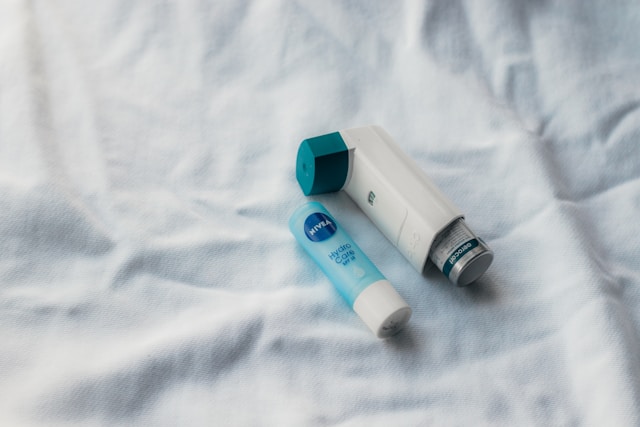
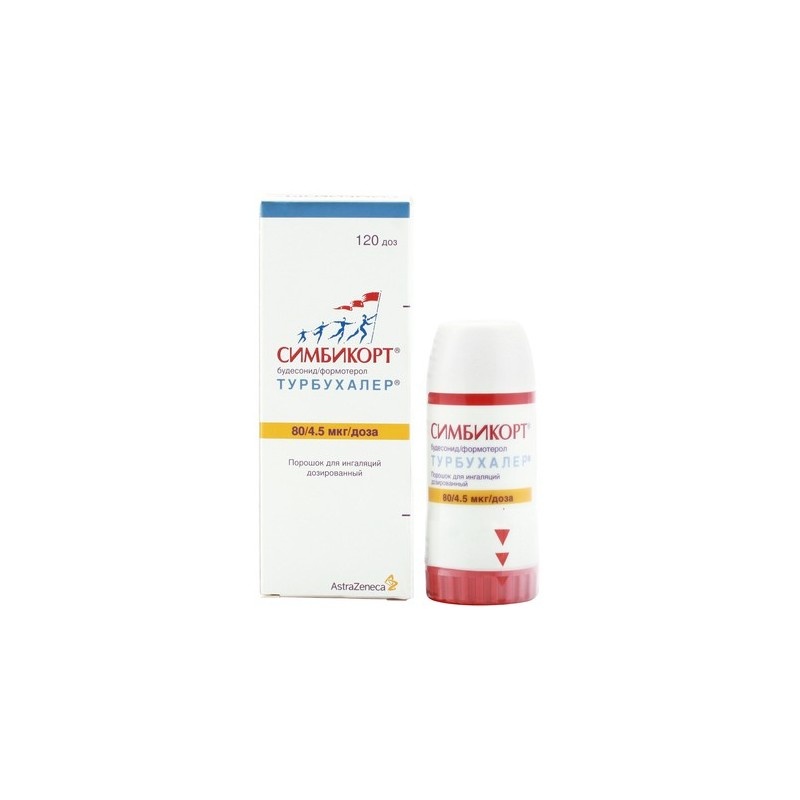
Simbicort Turbuhaler

Ask a doctor about a prescription for Simbicort Turbuhaler

How to use Simbicort Turbuhaler
Leaflet accompanying the packaging: information for the user
Symbicort Turbuhaler, (160 µg + 4.5 µg)/inhalation dose, inhalation powder
Budesonide + Formoterol fumarate dihydrate
Read the leaflet carefully before using the medicine, as it contains important information for the patient.
- Keep this leaflet, you may need to read it again.
- In case of any doubts, consult a doctor or pharmacist.
- This medicine has been prescribed specifically for you. Do not pass it on to others. The medicine may harm another person, even if their symptoms are the same.
- If the patient experiences any side effects, including any possible side effects not listed in this leaflet, they should tell their doctor or pharmacist. See section 4.
Table of contents of the leaflet:
- 1. What is Symbicort Turbuhaler and what is it used for
- 2. Important information before using Symbicort Turbuhaler
- 3. How to use Symbicort Turbuhaler
- 4. Possible side effects
- 5. How to store Symbicort Turbuhaler
- 6. Contents of the packaging and other information
1. What is Symbicort Turbuhaler and what is it used for
Symbicort Turbuhaler is an inhaler medicine used to treat asthma in adults and adolescents aged 12 to 17 years. It is also used to treat symptoms of chronic obstructive pulmonary disease (COPD) in adults aged 18 and over. It contains two different active substances: budesonide and formoterol fumarate dihydrate.
- Budesonide belongs to a group of medicines called corticosteroids. The medicine works by reducing and preventing swelling and inflammation in the lungs.
- Formoterol fumarate dihydrate belongs to a group of medicines called long-acting beta2-adrenergic receptor agonists or bronchodilators. Its action is to relax the muscles in the airways, making it easier to breathe.
Asthma
Symbicort Turbuhaler may be prescribed for asthma in two different ways.
a) Some patients are prescribed two inhalers for asthma: Symbicort Turbuhaler and a separate inhaler for emergency use.
Turbuhaler and a separate emergency inhaler.
- Symbicort Turbuhaler is used daily. Its use helps prevent the occurrence of asthma symptoms.
- The emergency inhaler is used when asthma symptoms occur to facilitate breathing.
b) Some patients are prescribed Symbicort Turbuhaler as the only inhaler for asthma.
- Symbicort Turbuhaler is used daily. Its use helps prevent the occurrence of asthma symptoms.
- Symbicort Turbuhaler is also used when additional doses are needed to relieve asthma symptoms and facilitate breathing, and if agreed with the doctor, also to prevent the occurrence of asthma symptoms (e.g. during physical exertion or exposure to allergens). These patients do not need a separate emergency inhaler.
Individuals using this regimen should always have Symbicort Turbuhaler with them and use it as needed. The total daily dose should not exceed 8 inhalations. The doctor may, however, recommend using up to 12 inhalations per day for a certain period.
If the patient regularly needs to use 8 or more inhalations per day, they should consult their doctor. A change in treatment may be necessary.
Do not use more than 12 inhalations per day.
If asthma symptoms occur during physical exertion, use Symbicort Turbuhaler as described above. It is essential to discuss the use of Symbicort Turbuhaler with the doctor to prevent the occurrence of asthma symptoms; how often the patient engages in significant physical exertion or is exposed to allergens, which may affect the prescribed treatment.
Chronic Obstructive Pulmonary Disease (COPD)
Symbicort Turbuhaler can also be used to treat COPD symptoms in adults. COPD is a chronic respiratory disease in the lungs, often caused by smoking.
2. Important information before using Symbicort Turbuhaler
When not to use Symbicort Turbuhaler:
Warnings and precautions
Before starting to use Symbicort Turbuhaler, the patient should talk to their doctor or pharmacist if they have:
- diabetes.
- pulmonary infection.
- high blood pressure or a history of heart disease (including arrhythmias, very rapid heart rate, artery narrowing, or heart failure).
- thyroid or adrenal gland disorders.
- low potassium levels in the blood.
- severe liver function disorders. If the patient experiences blurred vision or other vision disturbances, they should contact their doctor.
Symbicort Turbuhaler and other medicines
The patient should tell their doctor or pharmacist about all medicines they are currently taking or have recently taken, as well as any medicines they plan to take.
Particularly, the patient should inform their doctor or pharmacist if they are taking any of the following medicines:
- beta-blockers (such as atenolol or propranolol, used to treat high blood pressure), also in the form of eye drops (such as timolol used to treat glaucoma).
- medicines used for rapid or irregular heart rhythm (such as quinidine).
- medicines such as digoxin, often used to treat heart failure.
- diuretics (such as furosemide), used to treat high blood pressure.
- oral steroids (such as prednisolone).
- xanthine derivatives (e.g. theophylline or aminophylline). These are medicines often used to treat asthma.
- other bronchodilators (such as salbutamol).
- tricyclic antidepressants (such as amitriptyline) and the antidepressant nefazodone.
- phenothiazine medicines (such as chlorpromazine and prochlorperazine).
- HIV protease inhibitors (e.g. ritonavir) used to treat HIV infection.
- medicines used for infections (such as ketoconazole, itraconazole, voriconazole, posaconazole, clarithromycin, and telithromycin).
- medicines used for Parkinson's disease (e.g. levodopa).
- medicines used for thyroid disorders (e.g. levothyroxine).
A person taking any of the listed medicines or having doubts about taking other medicines should consult their doctor or pharmacist before using Symbicort Turbuhaler.
The patient should also inform their doctor or pharmacist about planned general anesthesia for a surgical or dental procedure.
Pregnancy, breastfeeding, and fertility
- If the patient is pregnant or plans to become pregnant, they should tell their doctor before using Symbicort Turbuhaler; they should not use Symbicort Turbuhaler without a doctor's recommendation.
- If a patient treated with Symbicort Turbuhaler becomes pregnant, they should not stop taking Symbicort Turbuhaler but should contact their doctor immediately.
- A breastfeeding patient should discuss the use of Symbicort Turbuhaler with their doctor before starting treatment.
Driving and using machines
Symbicort Turbuhaler has no or negligible influence on the ability to drive and use machines.
Symbicort Turbuhaler contains lactose
Symbicort Turbuhaler contains lactose (a type of sugar). If the patient has been diagnosed with intolerance to some sugars, they should talk to their doctor before taking this medicine. The amount of lactose in one dose of this medicine is usually not enough to cause symptoms in patients with lactose intolerance.
The lactose excipient contains small amounts of milk proteins, which may cause allergic reactions.
3. How to use Symbicort Turbuhaler
- This medicine should always be used as directed by the doctor. In case of doubts, consult a doctor or pharmacist.
- It is essential to use Symbicort Turbuhaler daily, even if the patient does not experience asthma or COPD symptoms at the time.
- If Symbicort Turbuhaler is used to treat asthma, the doctor will regularly check the severity of asthma symptoms.
If the patient is taking oral steroids in tablet form for asthma or COPD, when introducing Symbicort Turbuhaler, the doctor may reduce the number of oral steroid tablets taken. If the patient has been taking oral steroids in tablet form for a long time, the doctor may occasionally recommend blood tests. After reducing the dose of oral steroids, the patient may feel worse, and asthma symptoms may worsen. Symptoms such as a stuffy nose, runny nose, weakness, or muscle or joint pain and rash (skin rash) may occur. If any of these symptoms concern the patient or occur, they should contact their doctor immediately. Other medicines may be necessary if allergy or arthritis symptoms occur. If the patient has doubts about continuing to use Symbicort Turbuhaler, they should consult their doctor.
The doctor may consider adding oral steroids to the usual treatment during stressful periods (e.g., chest infection or before surgery).
Important information about asthma or COPD symptoms
If the patient experiences shortness of breath or wheezing while using Symbicort Turbuhaler, they should continue using Symbicort Turbuhaler but contact their doctor as soon as possible, as additional treatment may be necessary.
The patient should contact their doctor immediately if:
- they experience breathing difficulties or wake up at night due to an asthma attack.
- they have a feeling of chest tightness in the morning after waking up or if the chest tightness persists longer than usual.
- These symptoms may indicate inadequate control of asthma or COPD, and immediate use of other or additional treatment may be necessary.
Asthma
Symbicort Turbuhaler may be used to treat asthma in two different ways. The dose and frequency of use of Symbicort Turbuhaler depend on the recommended method of use.
a)
If the doctor has prescribed Symbicort Turbuhaler and an additional separate emergency inhaler, read the instructions in the section below marked with the symbol "a) Using Symbicort Turbuhaler and an additional emergency inhaler".
b)
If the doctor has prescribed Symbicort Turbuhaler as the only inhaler for asthma, read the instructions marked with the symbol "b) Using Symbicort Turbuhaler as the only inhaler for asthma".
a) Using Symbicort Turbuhaler and an additional emergency inhaler
Use Symbicort Turbuhaler daily.Using Symbicort Turbuhaler helps prevent the occurrence of asthma symptoms.
Adults (18 years and older)
- The usual dose is 1 or 2 inhalations twice a day.
- The doctor may increase the dose to 4 inhalations twice a day.
- If the symptoms are well-controlled, the doctor may recommend taking the medicine once a day.
Adolescents (12-17 years old)
- The usual dose is 1 or 2 inhalations twice a day.
- If the symptoms are well-controlled, the doctor may recommend taking the medicine once a day. For children aged 6-11, a lower-strength Symbicort Turbuhaler is available.
Symbicort Turbuhaler is not recommended for use in children under 6 years old.
During treatment, the doctor will help the patient with proper asthma treatment. The doctor will determine the smallest dose that controls asthma symptoms. Do not change the dose or stop using Symbicort Turbuhaler without consulting a doctor.
In case of asthma symptoms, use an additional emergency inhaler
for emergency use.The patient should always carry an additional emergency inhaler with them. Do not use Symbicort Turbuhaler to treat asthma symptoms - use the additional emergency inhaler for this purpose.
b) Using Symbicort Turbuhaler as the only inhaler for asthma
Symbicort Turbuhaler should only be used in this way if prescribed by a doctor and only for patients 12 years and older.
Use Symbicort Turbuhaler daily.This helps prevent the occurrence of asthma symptoms. The medicine can be taken in the following way:
- 1 inhalation in the morning and1 inhalation in the evening or
- 2 inhalations in the morning or
- 2 inhalations in the evening.
The doctor may increase the dose to 2 inhalations twice a day.
Use Symbicort Turbuhaler also as an "emergency inhaler"to treat asthma symptoms and to prevent the occurrence of asthma symptoms (e.g., during physical exertion or exposure to allergens).
- If asthma symptoms occur, take 1 inhalation and wait a few minutes.
- If the patient does not feel better, they should take another inhalation.
- Do not take more than 6 inhalations at once.
Always carry Symbicort Turbuhaler with you and use it as needed. The total daily dose should not exceed 8 inhalations. The doctor may, however, recommend using up to 12 inhalations per day for a certain period.
If the patient regularly needs to use 8 or more inhalations per day, they should consult their doctor. A change in treatment may be necessary.
Do not use more than 12 inhalations per day.
If asthma symptoms occur during physical exertion, use Symbicort Turbuhaler as described above. It is essential to discuss the use of Symbicort Turbuhaler with the doctor to prevent the occurrence of asthma symptoms; how often the patient engages in significant physical exertion or is exposed to allergens, which may affect the prescribed treatment.
Chronic Obstructive Pulmonary Disease (COPD)
- For use only in adults (18 years and older).
- The usual dose is 2 inhalations twice a day.
Patients with COPD may also be prescribed other bronchodilators by their doctor, such as anticholinergic medicines (e.g., tiotropium bromide and ipratropium bromide).
Preparing the Symbicort Turbuhaler inhaler for first use
Before firstuse of a newSymbicort Turbuhaler inhaler, prepare it for use as follows:
- Remove the cap from the inhaler. When removing the cap, a characteristic rattling sound may be heard.
- Hold the Symbicort Turbuhaler inhaler upright with the red wheel facing down.
- Turn the red wheel one full turn in one direction until it clicks, then turn it one full turn in the opposite direction (the direction you start turning the wheel does not matter). A characteristic click will be heard. It does not matter whether the click occurs after the first or second turn.
- Repeat the above step, turning the red wheel in both directions.
- The Symbicort Turbuhaler inhaler is now loaded and ready for use.
Using the inhaler
To take an inhalation, follow the steps below each time.
- 1. Remove the cap from the inhaler. When removing the cap, a characteristic rattling sound may be heard.
- 2. Hold the Symbicort Turbuhaler inhaler upright,with the red wheel facing down.
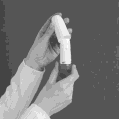
- 3. When loading the medicine, do not hold the Symbicort Turbuhaler inhaler by the mouthpiece. To load a dose of medicine, turn the red wheel until it clicks.
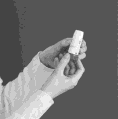
Then turn the wheel until it clicks again (the direction you start turning the wheel does not matter). A characteristic click will be heard. It does not matter whether the click occurs after the first or second turn.
The Symbicort Turbuhaler inhaler is now loaded and ready for use. Load the medicine dose only immediately before use.
- 4. Hold the Symbicort Turbuhaler inhaler away from your mouth. Take a slow breath out (without exertion). Do not breathe out through the Symbicort Turbuhaler inhaler mouthpiece.
- 5. Place the mouthpiece of the inhaler gently between your teeth. Close your mouth (enclose the mouthpiece with your lips) and take a deep and forceful breath in through your mouth. Do not chew or bite the mouthpiece.
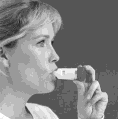
- 6. Remove the inhaler from your mouth. Take a slow breath out.The amount of medicine in one inhalation is very small, so the taste of the medicine may not be noticeable after inhalation. However, if the patient follows the instructions, they can be sure that the medicine dose has been taken and the medicine is in the lungs.
- 7. If a second inhalation is recommended, repeat the steps from 2 to 6.
- 8. After use, put the cap back on the inhaler and close it tightly.
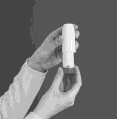
- 9. Rinse your mouth with water after taking a dose of medicine in the morning and (or) evening. Do not swallow the water.
Do not remove or turn the mouthpiece. It is connected to the Symbicort Turbuhaler inhaler and cannot be removed. Do not use a Symbicort Turbuhaler inhaler that has been damaged or if the mouthpiece is not attached to the inhaler.
As with all inhalers, caregivers should ensure that children prescribed Symbicort Turbuhaler use the correct inhalation technique, as described above.
Cleaning the Symbicort Turbuhaler inhaler
Wipe the outer surface of the mouthpiece with a dry cloth once a week. Do not use water or other liquids.
When to start using a new inhaler
- The dose counter window shows how many doses (inhalations) are left in the Symbicort Turbuhaler inhaler; a full inhaler contains 30, 60, or 120 doses of medicine.

- The dose counter scale is marked in increments of 10 inhalations (in inhalers containing 60 and 120 doses) and 15 inhalations (in the inhaler containing 30 doses). Therefore, the dose counter does not show a change after a single dose of medicine is taken.
- The appearance of a red mark on the edge of the dose counter window indicates that there are about 20 doses of medicine left in the inhaler. When taking the last 10 doses of medicine, the background of the dose counter window is red. When the number 0 on the red background is in the middle of the dose counter window, it means that a new Symbicort Turbuhaler inhaler should be started.
Note:
- After the inhaler is empty, the wheel will still turn and make a clicking sound.
- The sound heard when shaking the Symbicort Turbuhaler inhaler is made by the desiccant, not the medicine. Therefore, the contents of the Symbicort Turbuhaler inhaler cannot be assessed based on the sound made when shaking the inhaler.
- If more than one dose of medicine is loaded by mistake, the patient will still receive only one dose of medicine. However, all loaded doses will be recorded in the dose counter.
Using a higher than recommended dose of Symbicort Turbuhaler
It is essential to take the doses described in the leaflet or recommended by the doctor.
Do not increase the recommended dose without consulting a doctor.
The most common symptoms that may occur after taking a higher than recommended dose of Symbicort Turbuhaler are: tremors, headaches, and rapid heart rate.
Missing a dose of Symbicort Turbuhaler
- If a dose of medicine is missed, take it as soon as remembered. However, if it is almost time for the next dose, skip the missed dose.
- Do nottake a double dose to make up for a missed dose.
If the patient has any further doubts about using this medicine, they should consult their doctor or pharmacist.
4. Possible side effects
Like all medicines, this medicine can cause side effects, although not everybody gets them.
Stop using Symbicort Turbuhaler and contact a doctor immediately if the patient experiences any of the following symptoms:
- swelling of the face, especially around the mouth (tongue and/or throat and/or difficulty swallowing) or hives occurring at the same time as difficulty breathing (angioedema) and/or sudden feeling of weakness (fainting). This may indicate an allergic reaction. It occurs rarely, less often than in 1 in 1000 people.
- Sudden worsening of wheezing and shortness of breath occurring immediately after inhalation of the medicine.
If any of these symptoms occur, stop using Symbicort Turbuhaler and use an emergency inhaler. Contact a doctor immediately, as a change in treatment may be necessary.
Other possible side effects:
Common (may occur in less than 1 in 10 people)
- Palpitations (feeling of heart beating), tremors. If these symptoms occur, they are usually mild and usually disappear during continued use of Symbicort Turbuhaler.
- Thrush (fungal infection) in the mouth. The occurrence of thrush is less likely if the patient rinses their mouth with water after using Symbicort Turbuhaler.
- Mild throat irritation, cough, and hoarseness.
- Headaches.
- Pneumonia (lung infection) in patients with COPD.
Tell the doctor if the patient experiences any of the following symptoms, which may be signs of a lung infection:
- Fever or chills.
- Increased mucus production or change in mucus color.
- Worsening cough or increased breathing difficulties.
Uncommon (may occur in less than 1 in 100 people)
- Anxiety, nervousness, or agitation.
- Sleep disturbances.
- Dizziness.
- Nausea (feeling sick).
- Rapid heart rate.
- Bruises on the skin.
- Muscle cramps.
- Blurred vision.
Rare (may occur in less than 1 in 1000 people)
- Rash, itching.
- Bronchospasm (constriction of the airway muscles, manifested by wheezing). If wheezing occurs immediately after using the medicine, stop using Symbicort Turbuhaler and contact a doctor immediately.
- Low potassium levels in the blood.
- Irregular heartbeat.
Very rare (may occur in less than 1 in 10,000 people)
- Depression.
- Changes in behavior, especially in children.
- Chest pain or feeling of chest tightness (symptoms of angina pectoris).
- Increased blood sugar (glucose) levels.
- Taste disturbances, such as unpleasant taste in the mouth.
- Changes in blood pressure.
Inhaled corticosteroids may affect the production of steroid hormones in the body, especially if used for a long time in high doses. Symptoms include:
- changes in bone density (osteoporosis)
- cataracts (clouding of the lens in the eye)
- glaucoma (increased pressure in the eye)
- slowed growth in children and adolescents
- effects on the adrenal glands (small glands located near the kidneys).
The likelihood of these symptoms occurring is much lower when using inhaled corticosteroids than when taking corticosteroid tablets.
Reporting side effects
If the patient experiences any side effects, including any possible side effects not listed in this leaflet, they should tell their doctor or pharmacist. Side effects can be reported directly to the Department of Drug Safety Monitoring, Office for Registration of Medicinal Products, Medical Devices, and Biocidal Products, Al. Jerozolimskie 181C, 02-222 Warsaw, Tel.: +48 22 49 21 301, Fax: +48 22 49 21 309, website: https://smz.ezdrowie.gov.pl. Side effects can also be reported to the marketing authorization holder. By reporting side effects, more information can be collected on the safety of this medicine.
5. How to store Symbicort Turbuhaler
- Keep the medicine out of the sight and reach of children.
- Do not use this medicine after the expiry date stated on the carton or on the inhaler label after EXP. The expiry date refers to the last day of the month stated.
- There are no special precautions for storing the medicine.
- Medicines should not be disposed of via wastewater or household waste. Ask a pharmacist how to dispose of medicines that are no longer needed. This will help protect the environment.
6. Contents of the packaging and other information
What Symbicort Turbuhaler contains
The active substances of the medicine are budesonide and formoterol fumarate dihydrate. Each inhalation dose of Symbicort Turbuhaler contains 160 micrograms of budesonide and 4.5 micrograms of formoterol fumarate dihydrate.
The other ingredient of the medicine is lactose monohydrate (which contains milk proteins).
What Symbicort Turbuhaler looks like and contents of the pack
Symbicort Turbuhaler is an inhaler medicine. The inhalation powder is white. Each inhaler contains 30, 60, or 120 doses of medicine. The inhaler has a white body and a red wheel. On the wheel, there is a Braille code with the number 6, which allows identification and differentiation from other AstraZeneca inhalers.
Symbicort Turbuhaler is available in packs containing 1 inhaler with 30 doses or in packs containing 1, 2, 3, 10, or 18 inhalers with 60 or 120 doses. Not all pack sizes may be marketed.
Marketing authorization holder
AstraZeneca AB, 151 85 Södertälje, Sweden
Manufacturer
AstraZeneca AB, Forskargatan 18, 151 36 Södertälje, Sweden
This medicinal product is authorized in the Member States of the European Economic Area under the following names:
Austria:Symbicort Turbohaler 160 μg/4.5 μg/inhalation; Belgium:Symbicort Turbohaler 160 μg/4.5 μg/inhalation; Bulgaria:Symbicort Turbuhaler 160 μg/4.5 μg/inhalation; Croatia:Symbicort Turbuhaler 160 μg/4.5 μg/inhalation; Cyprus:Symbicort Turbuhaler 160 μg/4.5 μg/inhalation; Czech Republic:Symbicort Turbuhaler 160 μg/4.5 μg/inhalation; Denmark:Symbicort Turbuhaler 160 μg/4.5 μg/inhalation; Estonia:Symbicort Turbuhaler 160 μg/4.5 μg; Finland:Symbicort Turbuhaler 160 μg/4.5 μg/inhalation; France:Symbicort Turbuhaler 200 μg/6 μg/inhalation; Germany:Symbicort Turbuhaler 160 μg/4.5 μg/inhalation; Greece:SYMBICORT TURBUHALER 160 μg/4.5 μg/inhalation; Hungary:Symbicort Turbuhaler 160 μg/4.5 μg/inhalation; Iceland:Symbicort Turbuhaler 160 μg/4.5 μg/inhalation; Ireland:Symbicort Turbohaler 200 μg/6 μg/inhalation; Italy:SYMBICORT 160 μg/4.5 μg/inhalation; Latvia:Symbicort Turbuhaler 160 μg/4.5 μg/inhalation; Lithuania:Symbicort Turbuhaler 160 μg/4.5 μg/dose; Luxembourg:Symbicort Turbohaler 160 μg/4.5 μg/inhalation; Malta:Symbicort Turbohaler 200 μg/6 μg/inhalation; Netherlands:Symbicort Turbuhaler 200 μg/6 μg/inhalation; Norway:Symbicort Turbuhaler 160 μg/4.5 μg/inhalation; Poland:Symbicort Turbuhaler (160 μg+4.5 μg)/inhalation dose; Portugal:Symbicort Turbohaler 160 μg/4.5 μg/inhalation; Romania:Symbicort Turbuhaler 160 μg/4.5 μg/inhalation; Slovakia:Symbicort Turbuhaler 200 μg/6 μg/inhalation; Slovenia:Symbicort Turbuhaler 160 μg/4.5 μg/inhalation; Spain:Symbicort Turbuhaler 160 μg/4.5 μg/inhalation; Sweden:Symbicort Turbuhaler 160 μg/4.5 μg/inhalation; United Kingdom:Symbicort 200 μg/6 μg/inhalation Turbohaler.
For more detailed information, please contact the representative of the marketing authorization holder:
AstraZeneca Pharma Poland Sp. z o.o., ul. Postępu 14, 02-676 Warsaw, tel.: +48 22 245 73 00, fax: +48 22 485 30 07.
Date of last revision of the leaflet:October 2023
Detailed and up-to-date information about this product is available by scanning the QR code on the Patient Leaflet and the outer packaging of the medicine with a smartphone. The same information is also available on the website: www.turbuhaler.pl
QR code area
- Country of registration
- Active substance
- Prescription requiredYes
- Manufacturer
- ImporterAstraZeneca AB
- This information is for reference only and does not constitute medical advice. Always consult a licensed doctor before taking any medication. Oladoctor is not responsible for medical decisions based on this content.
- Alternatives to Simbicort TurbuhalerDosage form: Powder, (160 mcg + 4.5 mcg)/inh. doseActive substance: formoterol and budesonidePrescription requiredDosage form: Powder, (320 mcg + 9 mcg)/inh. doseActive substance: formoterol and budesonideManufacturer: Aeropharm GmbH Lek farmacevtska družba d.d. (Lek Pharmaceuticals d.d.) Salutas Pharma GmbHPrescription requiredDosage form: Powder, (160 mcg + 4.5 mcg)/inh. doseActive substance: formoterol and budesonideManufacturer: Orion CorporationPrescription required
Alternatives to Simbicort Turbuhaler in other countries
The best alternatives with the same active ingredient and therapeutic effect.
Alternative to Simbicort Turbuhaler in Ukraine
Alternative to Simbicort Turbuhaler in Spain
Online doctors for Simbicort Turbuhaler
Discuss dosage, side effects, interactions, contraindications, and prescription renewal for Simbicort Turbuhaler – subject to medical assessment and local rules.




